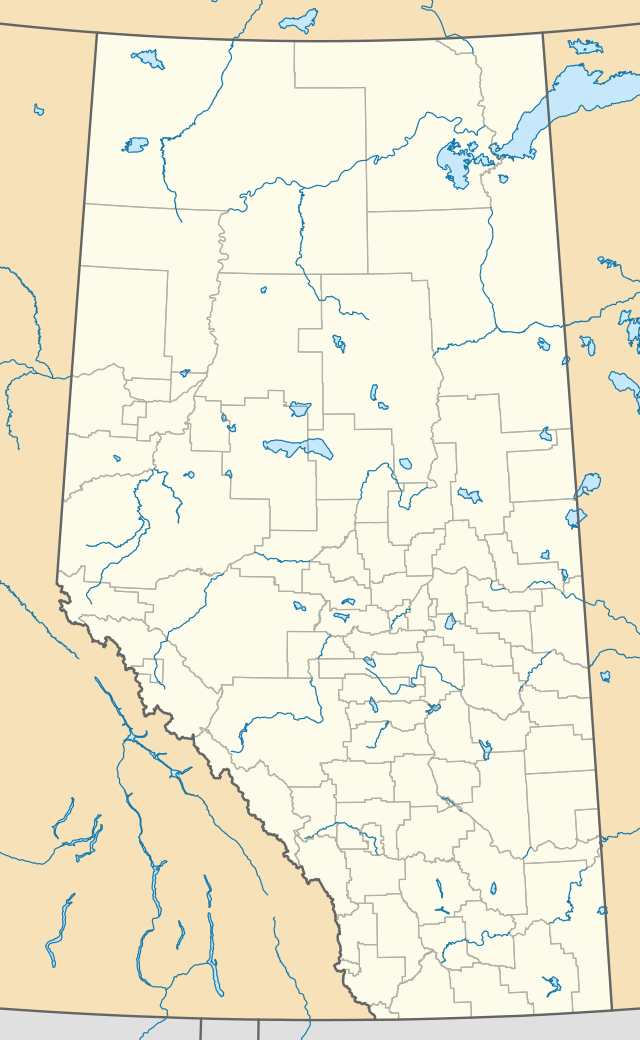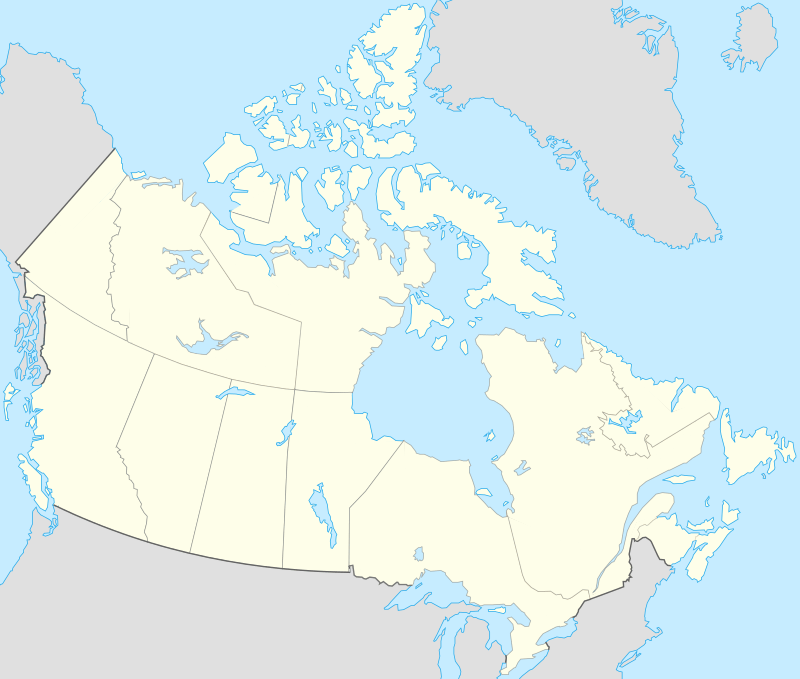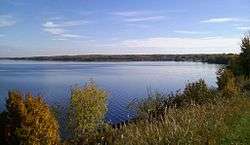Lac La Biche, Alberta
Lac La Biche (/ˌlæk lə ˈbɪʃ/ LAK lə BISH) is a hamlet in Lac La Biche County within northeast Alberta, Canada.[5] It is located approximately 220 km (140 mi) northeast of the provincial capital of Edmonton. Previously incorporated as a town, Lac La Biche amalgamated with Lakeland County to form Lac La Biche County on August 1, 2007.[1]
Lac La Biche | |
|---|---|
Urban service area (hamlet) | |
 Main street | |
| Motto(s): Welcoming by Nature | |
 Location within Lac La Biche County | |
 Lac La Biche Location of Lac La Biche in Alberta  Lac La Biche Lac La Biche (Canada) | |
| Coordinates: 54°46′13″N 111°58′45″W | |
| Country | Canada |
| Province | Alberta |
| Region | Northern Alberta |
| Planning region | Lower Athabasca |
| Specialized municipality | Lac la Biche |
| Founded | October 4, 1798 |
| Dissolved | August 1, 2007[1] |
| Government | |
| • Mayor | Omer Moghrabi |
| • Governing body | Lac La Biche County Council
|
| Area (2016)[2] | |
| • Total | 6.05 km2 (2.34 sq mi) |
| Elevation | 560 m (1,840 ft) |
| Population | |
| • Total | 2,314 |
| • Density | 382.4/km2 (990/sq mi) |
| • Population centre | 2,294 |
| • Population centre density | 791.0/km2 (2,049/sq mi) |
| Time zone | UTC−7 (MST) |
| • Summer (DST) | UTC−6 (MDT) |
| Postal code span | T0A 2C0-T0A 2C2 & T0A 3Z0 |
| Area code(s) | -1+780 |
| Highways | Highway 55 Highway 36 Highway 881 |
| Waterway | Lac la Biche |
| Website | laclabichecounty.com |
| Official name | Notre Dame des Victoires / Lac La Biche Mission National Historic Site of Canada |
| Designated | 1989 |
Etymology
The indigenous peoples of the area referred to the lake as Elk Lake (Nêhiyawêwin: wâwâskesiwisâkahikan,[6] Dënesųłiné: tzalith tway).[7] The earliest Europeans translated this name into English as "Red Deer Lake" and in French as "Lac la biche" ("Lake of the doe"). Over time, the French name came to be used in English as well.
History

Historic voyageur highway
Lac La Biche was on the historical voyageur route that linked the Athabaskan region to Hudson Bay. David Thompson and George Simpson used the fur trade route via the Beaver River from the main Methye Portage route that reached the Athabasca River.[8] Thompson was the first known European to record his sojourn on Lac La Biche. Thompson, who referred to the lake as Red Deers Lake, arrived October 4, 1798 and overwintered there. He entered copious notes in his diary on the Nahathaway (the Cree), their customs, traditions, and the Western Forest Land, including the large supply of whitefish and beaver.[9]
Fur trade posts
Although the Montreal-based North West Company was already active in the area,[10] Thompson established the first permanent settlement in Lac La Biche on his 1798 trip, a Hudson's Bay Company trading post [11] which he named Red Deers Lake House.[12] In 1799, Peter Fidler arrived in the area after Thompson's departure, and assisted in building a more permanent structure for the post. This new structure was known as Greenwich House. It was also abandoned by 1801, but Lac La Biche was established as a permanent place of residence for some French-Canadian and Métis freetraders and their families.[13] Fur trade activity continued unbroken, due to the importance of the portage, and Lac La Biche was visited by fur traders such as Gabriel Franchère and Ross Cox. David Thompson returned in 1812.[13]
Another temporary Hudson's Bay Company post was erected in 1817, but the portage was abandoned by the company in 1825. Almost no written records exist for the following two decades.[13]
Oblate mission
A Roman Catholic mission was established in 1853 by Oblate missionaries. Historian Paul Robert Magocsi notes how the settlement grew over the next few decades:
"The French-speaking element, mostly from Red River, coalesced around the Mission. It formed a community that was tightly knit, even though the influence of the church lessened and the trend was towards marrying out and establishing nuclear families. Living was largely off the land; logging and road work provided intermittent wage labour. Many of the adults were trilingual, speaking French and Cree as well as English."[14]
The Lac La Biche Mission is now a National Historic Site and Provincial Historic Resource. It was the site of one of the first residential schools in Alberta.[15][16]
Treaties and insurrection
The Government of Canada sought to extinguish the First Nations' title to the land across the prairies, in order to open the land up to settlement. Treaty 6 was negotiated in 1876 and covered the lands to the south of Lac La Biche.[17]
The new Hudson's Bay Company post at Lac La Biche was looted on April 26, 1885 during the Northwest Rebellion by members of Big Bear's band. Their plan to loot the nearby Roman Catholic Mission was stopped by the local Cree and Métis population.[18] Métis Scrip Records show many residents of the area were awarded scrip by the Government of Canada from 1885 until the 1920s.[12]
Treaty 8, covering the lands north of Lac La Biche, was negotiated in 1899. This set the stage for rail and settlement.
Demographics
As a designated place in the 2016 Census of Population conducted by Statistics Canada, Lac La Biche recorded a population of 2,314 living in 895 of its 1,048 total private dwellings, a change of -8.2% from its 2011 population of 2,520. With a land area of 6.05 km2 (2.34 sq mi), it had a population density of 382.5/km2 (990.6/sq mi) in 2016.[2]
Lac La Biche County's 2016 municipal census counted a population of 2,682 in Lac La Biche,[19] a -7.4% change from its 2013 municipal census population of 2,895.[20]
In the 2011 Census, the dissolved Town of Lac La Biche had a population of 2,520 living in 929 of its 1,038 total dwellings, a −8.6% change from its 2006 population of 2,758. With a land area of 6.18 km2 (2.39 sq mi), it had a population density of 407.8/km2 (1,056.1/sq mi) in 2011.[4]
As a population centre in the 2011 Census, Lac La Biche had a population of 2,544 living in 938 of its 1,047 total dwellings, a −7.8% change from its 2006 population of 2,758. With a land area of 6.2 km2 (2.4 sq mi), it had a population density of 410/km2 (1,063/sq mi) in 2011.[21]
Economy
The community is supported by the oil patch, logging, forestry, agriculture, and commercial fishing.
Jamie Davis Towing (featured on the Highway Thru Hell reality show) has an operation in Lac La Biche.[22][23]
Attractions

Lac La Biche is home to the Lac La Biche Golf Course,[24] while numerous lakes and campgrounds provide outdoor recreation opportunities in the area, including Lakeland Provincial Park to the east. Lac La Biche County has a small museum [25] dedicated to sharing the history of the area, it is located in the Jubilee Hall building, beside the recreation grounds where the baseball diamonds, splash park, and green space are also located.
Government
| MLAs representing Lac La Biche | ||||
|---|---|---|---|---|
| Assembly | Years | Member | Party | |
| Part of Victoria (N.W.T.) | ||||
| 3rd | 1894–1898 | Frank Tims | Independent | |
| 4th | 1898–1902 | Jack Shera | ||
| 5th | 1902–1905 | |||
| Part of Victoria | ||||
| 1st | 1905–1909 | Francis Walker | Liberal | |
| Part of Pakan | ||||
| 2nd | 1909–1913 | Prosper-Edmond Lessard | Liberal | |
| Part of Beaver River | ||||
| 3rd | 1913–1917 | Wilfrid Gariépy | Liberal | |
| 4th | 1917–1921 | |||
| 5th | 1921–1926 | Joseph Dechêne | ||
| 6th | 1926–1930 | John Delisle | United Farmers | |
| 7th | 1930–1935 | Henry Dakin | Liberal | |
| 8th | 1935–1940 | Lucien Maynard | Social Credit | |
| 9th | 1940–1944 | |||
| 10th | 1944–1948 | |||
| 11th | 1948–1952 | Harry Lobay | ||
| Part of Lac La Biche | ||||
| 12th | 1952–1955 | Harry Lobay | Social Credit | |
| 13th | 1955–1959 | Michael Maccagno | Liberal | |
| 14th | 1959–1963 | |||
| 15th | 1963–1967 | |||
| 16th | 1967–1968 | |||
| 1968 | Vacant | |||
| 1968–1971 | Damase Bouvier | Social Credit | ||
| Part of Lac La Biche-McMurray | ||||
| 17th | 1971–1972 | Damase Bouvier | Social Credit | |
| 1972–1975 | Independent | |||
| 18th | 1975–1979 | Ron Tesolin | Progressive Conservative | |
| 19th | 1979–1982 | Norm Weiss | ||
| 20th | 1982–1986 | |||
| Part of Athabasca-Lac La Biche | ||||
| 21st | 1986–1989 | Leo Piquette | New Democrat | |
| 22nd | 1989–1993 | Mike Cardinal | Progressive Conservative | |
| Part of Lac La Biche-St. Paul | ||||
| 23rd | 1993–1994 | Paul Langevin | Liberal | |
| 1994–1995 | Independent | |||
| 1995–1997 | Progressive Conservative | |||
| 24th | 1997–2001 | |||
| 25th | 2001–2004 | Ray Danyluk | ||
| 26th | 2004–2008 | |||
| 27th | 2008–2012 | |||
| Part of Lac La Biche-St. Paul-Two Hills | ||||
| 28th | 2012–2015 | Shayne Saskiw | Wildrose | |
| 29th | 2015–2017 | Dave Hanson | ||
| 2017–2019 | United Conservative | |||
| Part of Fort McMurray-Lac La Biche | ||||
| 30th | 2019– | Laila Goodridge | United Conservative | |
The Hamlet of Lac La Biche comprises Lac La Biche County's Ward 7.[1] Omer Moghrabi was elected as mayor in 2017, Councillors Lorin Tkachuk and Colin Cote represent Ward 7 on Lac La Biche County Council.[26] Provincially, the community has been represented by every major political party in Alberta history (expand table for details).
Infrastructure

Lac La Biche Airport (YLB) is located 1.5 nautical miles (2.8 km; 1.7 mi) west of Lac La Biche. It features a fully serviced 5,700 by 100 ft (1,737 by 30 m) paved airstrip.
Education
The main campus of Portage College is located in Lac La Biche. The college has an ACAC hockey team named the Portage Voyageurs. The team's first season began in the fall of 2008.[27]
- Northern Lights School Division No. 69
- Vera M. Welsh Elementary School (K-3)
- Aurora Middle School (4–8)
- J.A. Williams High School (9–12)
- Lac La Biche Off-Campus (8–12)
Media
Media outlets serving Lac La Biche and area include the Lac La Biche Post weekly newspaper[28] and the Boom 103.5 radio station.[29]
See also
References
- Province of Alberta (April 1, 2007). "Order in Council (O.C.) 332-2007". Retrieved March 11, 2010.
- "Population and dwelling counts, for Canada, provinces and territories, and designated places, 2016 and 2011 censuses – 100% data (Alberta)". Statistics Canada. February 8, 2017. Retrieved February 13, 2017.
- "Alberta Private Sewage Systems 2009 Standard of Practice Handbook: Appendix A.3 Alberta Design Data (A.3.A. Alberta Climate Design Data by Town)" (PDF) (PDF). Safety Codes Council. January 2012. pp. 212–215 (PDF pages 226–229). Retrieved October 8, 2013.
- "Census Profile – Lac La Biche, Town, Alberta (Dissolved census subdivision)". Statistics Canada. November 2, 2012. Retrieved December 2, 2012.
- Alberta Municipal Affairs (April 1, 2010). "Specialized and Rural Municipalities and Their Communities" (PDF). Archived from the original (PDF) on February 29, 2012. Retrieved June 28, 2010.
- "Online Cree Dictionary: ᐋᐧᐋᐧᐢᑫᓯᐃᐧᓵᑲᐦᐃᑲᐣ". Retrieved 2018-09-17.
- Fromhold, Joachim (2001). 2001 Indian Place Names of the West - Part 1. Calgary: Lulu. pp. CCC. ISBN 9780557438365.
- "Disclaimer – Electronic Collection". Epe.lac-bac.gc.ca. Retrieved July 30, 2013.
- Thompson 1916, pp. 304–305.
- Johnson, Gregory A. (1999). Lac La Biche chronicles : the early years. Portage College. p. 74. ISBN 0-9686178-0-8.
- Thompson 1916, p. 304.
- Barkwell 2013.
- Johnson, Gregory A. (1999). Lac La Biche chronicles : the early years. Portage College. p. 100. ISBN 0-9686178-0-8.
- Dickason 1999, p. 77.
- Canada's Historic Places. "Notre Dame des Victoires / Lac La Biche Mission National Historic Site". Retrieved 2014-01-19.
- Lac La Biche Mission. "Lac La Biche Mission national historic site". Retrieved December 25, 2009.
- Johnson, Gregory A. (1999). Lac La Biche chronicles : the early years. Portage College. p. 151. ISBN 0-9686178-0-8.
- Heather Devine (2004). The People who Own Themselves: Aboriginal Ethnogenesis in a Canadian Family, 1660–1900. University of Calgary Press. p. 162. ISBN 978-1-55238-115-1.
- "Lac La Biche County 2016 Municipal Census Report". Lac La Biche County. p. 13. Retrieved January 28, 2017.
- "2013 Census Summary". Lac La Biche County. p. 6. Retrieved January 28, 2017.
- "Census Profile – Lac La Biche, Alberta (Population centre)". Statistics Canada. February 8, 2012. Retrieved February 8, 2012.
- https://calgaryherald.com/entertainment/television/season-5-of-highway-thru-hell-has-jamie-davis-and-his-crew-dealing-with-a-different-type-of-crash-albertas-economy
- https://www.truckersnews.com/controlling-traffic-turns-hellish-on-highway-thru-hell/
- "Lac La Biche Golf & Country Club". Lac La Biche Golf & Country Club. Retrieved January 28, 2013.
- "Lac La Biche Museum". Lac La Biche Museum. Retrieved February 15, 2019.
- "Council". Lac La Biche County. Retrieved July 10, 2013.
- Voyageur Athletics Archived 2010-03-28 at the Wayback Machine
- "Lac La Biche Post". Great West Newspapers LP. Retrieved January 28, 2013.
- "Boom 103.5 - 80's & 90's". Boom 103.5. Boom 103.5 FM. Retrieved July 21, 2017.
Sources
| Wikivoyage has a travel guide for Lac La Biche. |
- Barkwell, Lawrence J. (2013). Metis scrip claims from Lac la Biche, Alberta under the Dominion Lands Act (Report).CS1 maint: ref=harv (link)
- Dickason, Olive P. (1999). "Metis". In Paul Robert Magocsi (ed.). The Encyclopedia of Canada's Peoples. Toronto, Ontario: University of Toronto Press. ISBN 0-8020-2938-8.CS1 maint: ref=harv (link)
- Thompson, David (1916). J. B. Tyrrell (ed.). David Thompson's Narrative of his Explorations in Western America 1784–1812. Toronto: Champlain Society.CS1 maint: ref=harv (link) This is the full-text diary of David Thompson which includes numerous references to the Nahathaway in general and to the First Nations of the Lac la Biche region in particular. He describes their belief in life after death and consequences on the human soul for crimes and misdeeds.